Intelligent Power Management System Using Hybrid Renewable Energy Resources and Decision Tree Approach †
Abstract
:1. Introduction
2. Internet of Things and Artificial Intelligence Infrastructure on eoTICC Project
- Things. Today there are millions of things (sensors/actuators and devices found in commercial and industrial settings) connected directly through wireless networks and accessing the Internet. Usually, the IoT solutions have things filtered and managed using data locally and/or connected to gateways that provide extended functionality. Basic devices are tagged like things. Each thing has data that can be shared in the Internet.
- Local Gateway. Most of existing things were not designed to connect to the Internet and cannot share data with the cloud. To resolve this difficulty gateways act as intermediaries between things and the cloud, providing the needed connectivity, security, and manageability.
- Network and Cloud. Cloud infrastructure contains large pools of virtualized servers and storage that are networked together. IoT solutions run applications that analyse and manage data from devices and sensors in order to generate services that produce information used in decision making.
3. Materials and Methods
- Learning power consumption patterns
- Forecast power consumption and forecast power generation.
- Home appliances control using forecast data and decision trees.
4. Results
- Iot node connects to open weather services to obtain hourly weather forecast.
- Solar and wind data are analysed.
- Power generation is estimated.
- Power consumption is calculated and an algorithm with decision trees decides control actions.
- Process 1: Data capture. An algorithm captures system data: rpm wind turbine, wind and solar energy generated, power consumption, ambient data, controllers and other. This algorithm communicates these data to cloud and other control processes.
- Process 2: Forecast. Hourly algorithm that is connected to open internet weather data. This algorithm calculates the power generation and consumption forecasts. It uses rules based on decision trees. The first decision tree is shown in Figure 9.
- Process 3. Decision tree and control. This algorithm controls the installation: start/stop, security and others. Decision tree data allows processing different control strategies.
- Process 4. Cloud services. A cloud platform is used to implement dashboard monitoring, storage and control.
5. Conclusions
Author Contributions
Acknowledgments
References
- Ferrández-Pastor, F.J.; García-Chamizo, J.M.; Nieto-Hidalgo, M.; Mora-Pascual, J.; Mora-Martínez, J. Developing Ubiquitous Sensor Network Platform Using Internet of Things: Application in Precision Agriculture. Sensors 2016, 16, 1141. [Google Scholar] [CrossRef] [PubMed]
- Al-Sarawi, S.; Anbar, M.; Alieyan, K.; Alzubaidi, M. Internet of Things (IoT) communication protocols: Review. In Proceedings of the 2017 8th International Conference on Information Technology (ICIT), Singapore, 27–29 December 2017; pp. 685–690. [Google Scholar]
- Heđi, I.; Špeh, I.; Šarabok, A. IoT network protocols comparison for the purpose of IoT constrained networks. In Proceedings of the 2017 40th International Convention on Information and Communication Technology, Electronics and Microelectronics (MIPRO), Opatija, Croatia, 22–26 May 2017; pp. 501–505. [Google Scholar]
- MQTT org. Available online: http://mqtt.org (accessed on 26 May 2018).
- Davis, E.G.; Calveras, A.; Demirkol, I. Improving Packet Delivery Performance of Publish/Subscribe Protocols in Wireless Sensor Networks. Sensors 2013, 13, 648–680. [Google Scholar] [CrossRef] [PubMed]
- Alvarez-Campana, M.; López, G.; Vázquez, E.; Villagrá, V.A.; Berrocal, J. Smart CEI Moncloa: An IoT-based Platform for People Flow and Environmental Monitoring on a Smart University Campus. Sensors 2017, 17, 2856. [Google Scholar] [CrossRef] [PubMed]
- Atmoko, R.A.; Riantini, R.; Hasin, M.K. IoT real time data acquisition using MQTT protocol. J. Phys. Conf. Ser. 2017, 853, 012003. [Google Scholar] [CrossRef]
- Wang, Z.; Srinivasan, R.S. A review of artificial intelligence based building energy use prediction: Contrasting the capabilities of single and ensemble prediction models. Renew. Sustain. Energy Rev. 2017, 75, 796–808. [Google Scholar] [CrossRef]
- Le, M.-H.; Ploix, S. Robust anticipative energy management system: Application of a smart building platform. Build. Serv. Eng. Res. Technol. 2017, 38, 226–248. [Google Scholar] [CrossRef]
- Fong, S.; Li, J.; Song, W.; Tian, Y.; Wong, R.K.; Dey, N. Predicting unusual energy consumption events from smart home sensor network by data stream mining with misclassified recall. J. Ambient Intell. Humanized Comput. 2018, 9, 1–25. [Google Scholar] [CrossRef]
- Ferrández-Pastor, F.J.; Mora-Mora, H.; Sánchez-Romero, J.L. Interpreting human activity from electrical consumption data using reconfigurable hardware and hidden Markov models. J. Ambient Intell. Hum. Comput. 2017, 8, 469–483. [Google Scholar] [CrossRef]
- Lai, C.-F.; Yang, Y.-H.; Chao, L.; Chao, H.-C. Integration of IoT Energy Management System with Appliance and Activity Recognition. In Proceedings of the 2012 IEEE International Conference on Green Computing and Communications, Besancon, France, 20–23 November 2012; pp. 66–71. [Google Scholar] [CrossRef]
- Cho, W.-T.; Lai, Y.-X.; Lai, C.-F.; Huang, Y.-M. Appliance-Aware Activity Recognition Mechanism for IoT Energy Management System. Comput. J. 2013, 56, 1020–1033. [Google Scholar] [CrossRef]
- Kaur, K.; Kaur, K. A study of power management techniques for Internet of Things (IoT). In Proceedings of the 2016 International Conference on Electrical, Electronics, and Optimization Techniques (ICEEOT), Chennai, India, 3–5 March 2016; pp. 1781–1785. [Google Scholar] [CrossRef]
- Tschofenig, H.; Arkko, J.; Thaler, D.; McPherson, D.; Internet Architecture Board (IAB). Architectural Considerations in Smart Object Networking. 2015. Available online: https://tools.ietf.org/html/rfc7452 (accessed on 26 May 2018).
- National Instruments. Wind Turbine Control Methods. 2008. Available online: http://www.ni.com/white-paper/8189/en/ (accessed on 26 May 2018).
- Lydia, M.; Suresh Kumar, S.; Immanuel Selvakumar, A.; Edwin Prem Kumar, G. A comprehensive review on wind turbine power curve modeling techniques. Renew. Sustain. Energy Rev. 2014, 30, 452–460. [Google Scholar] [CrossRef]
- Lu, Q.; Li, Q.; Kim, Y.K.; Kim, K.C. A study on design and aerodynamic characteristics of a spiral-type wind turbine blade. J. Korean Soc. Visual. 2012, 10, 27–33. [Google Scholar] [CrossRef]
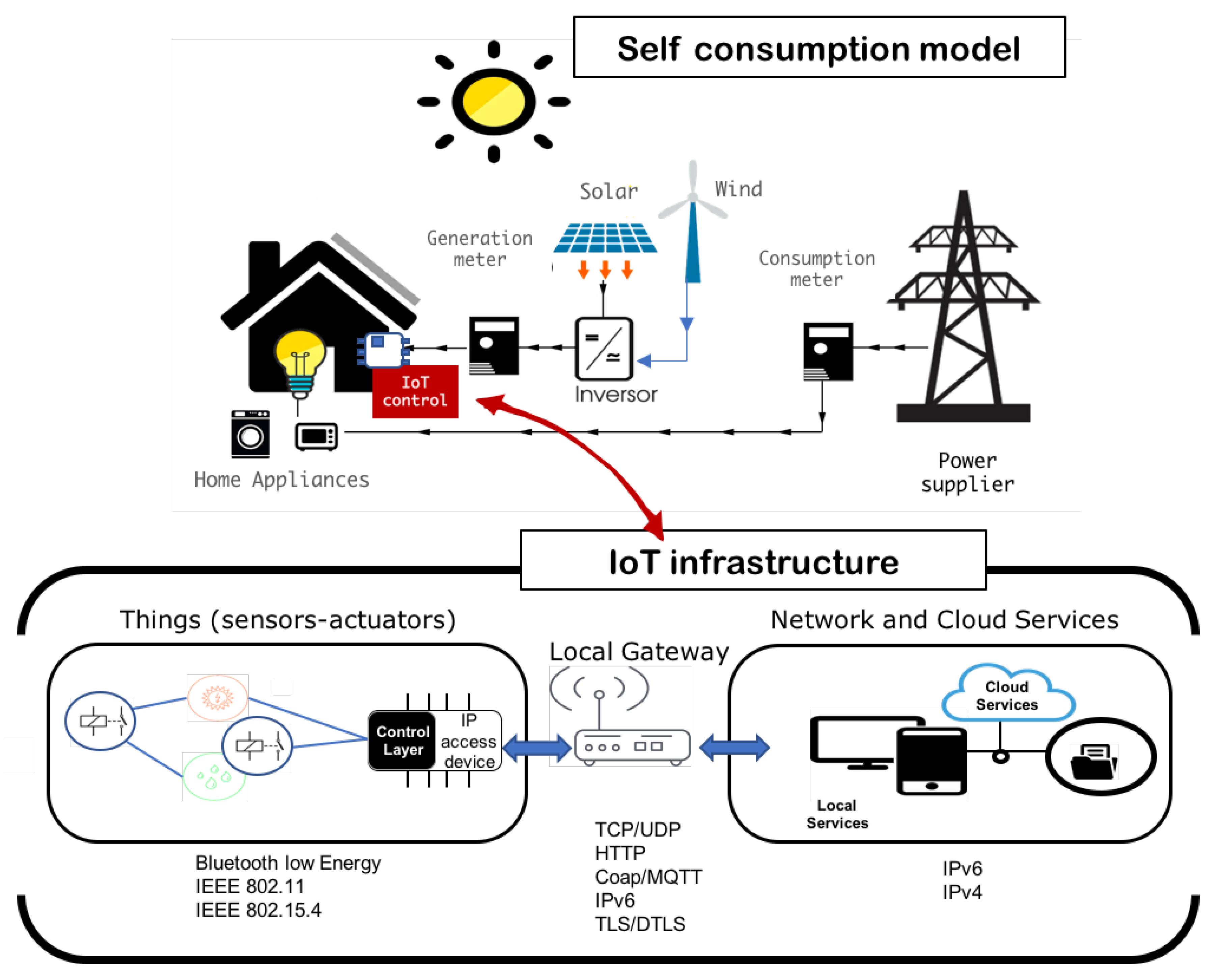
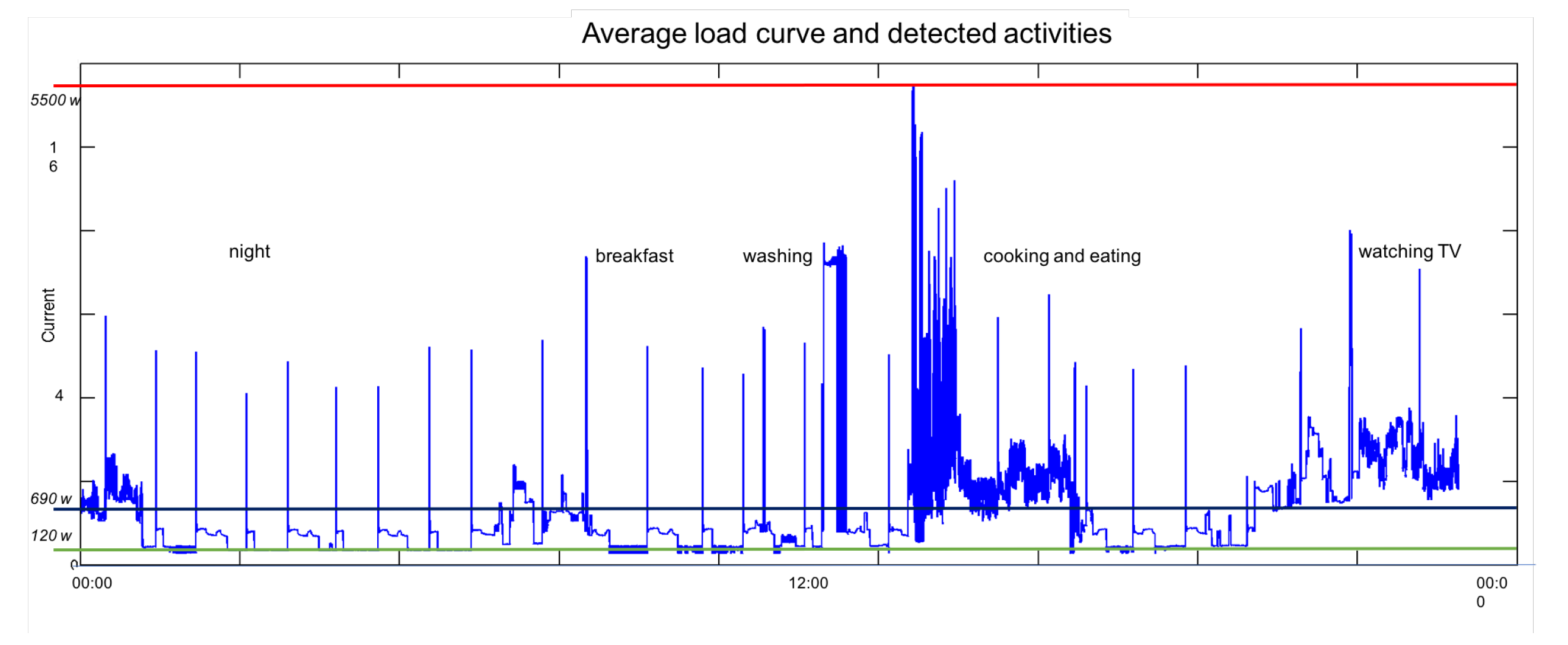
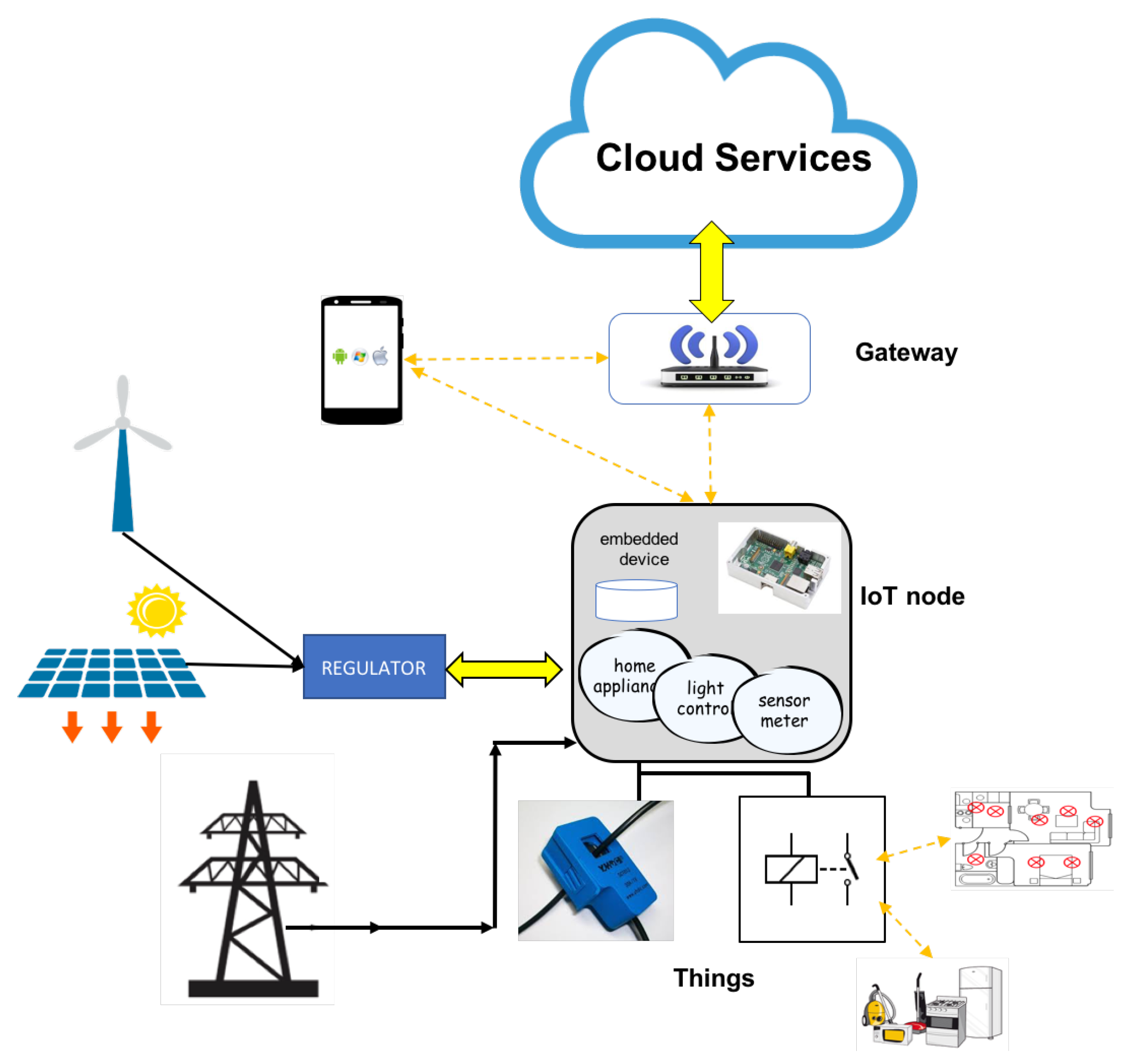




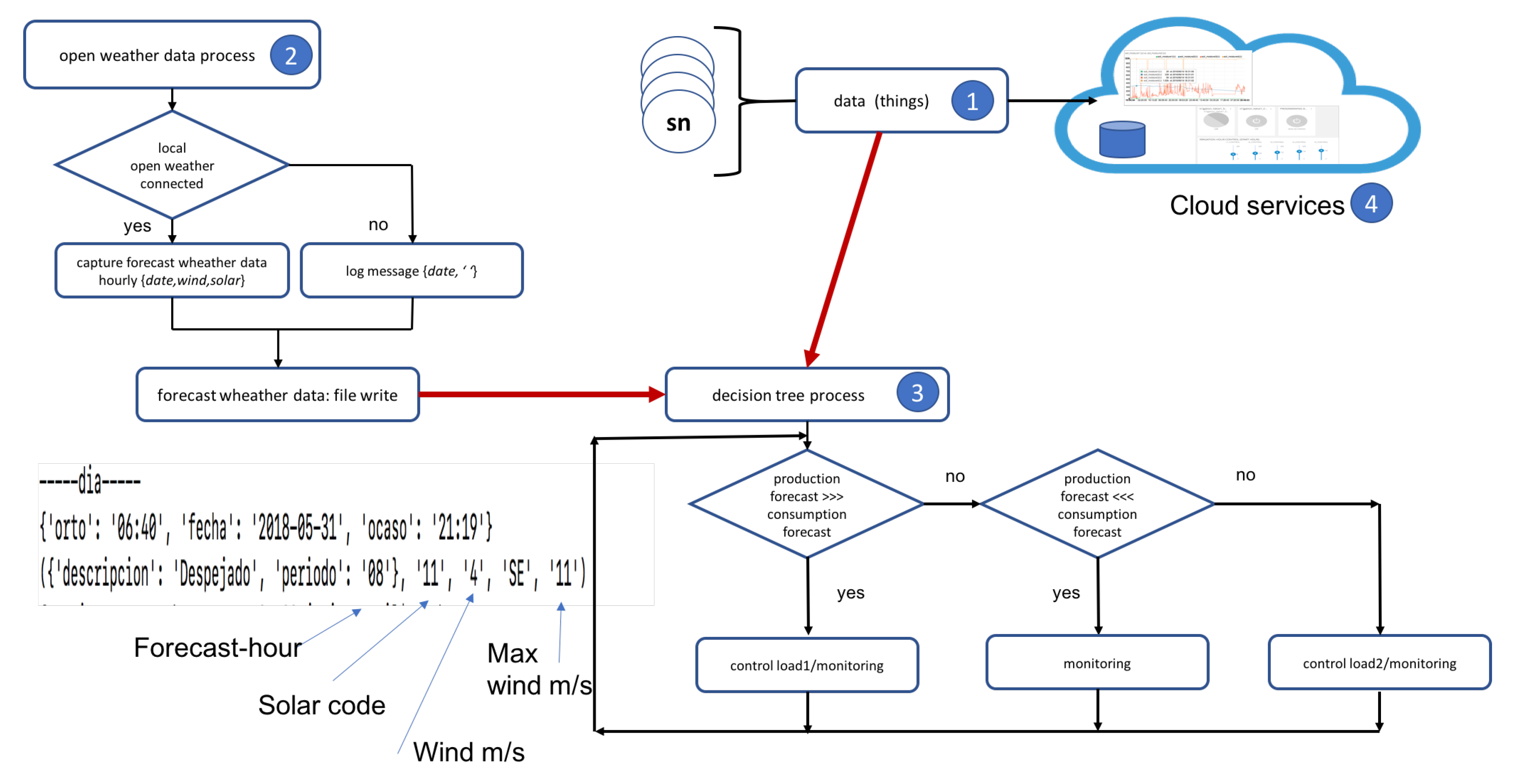
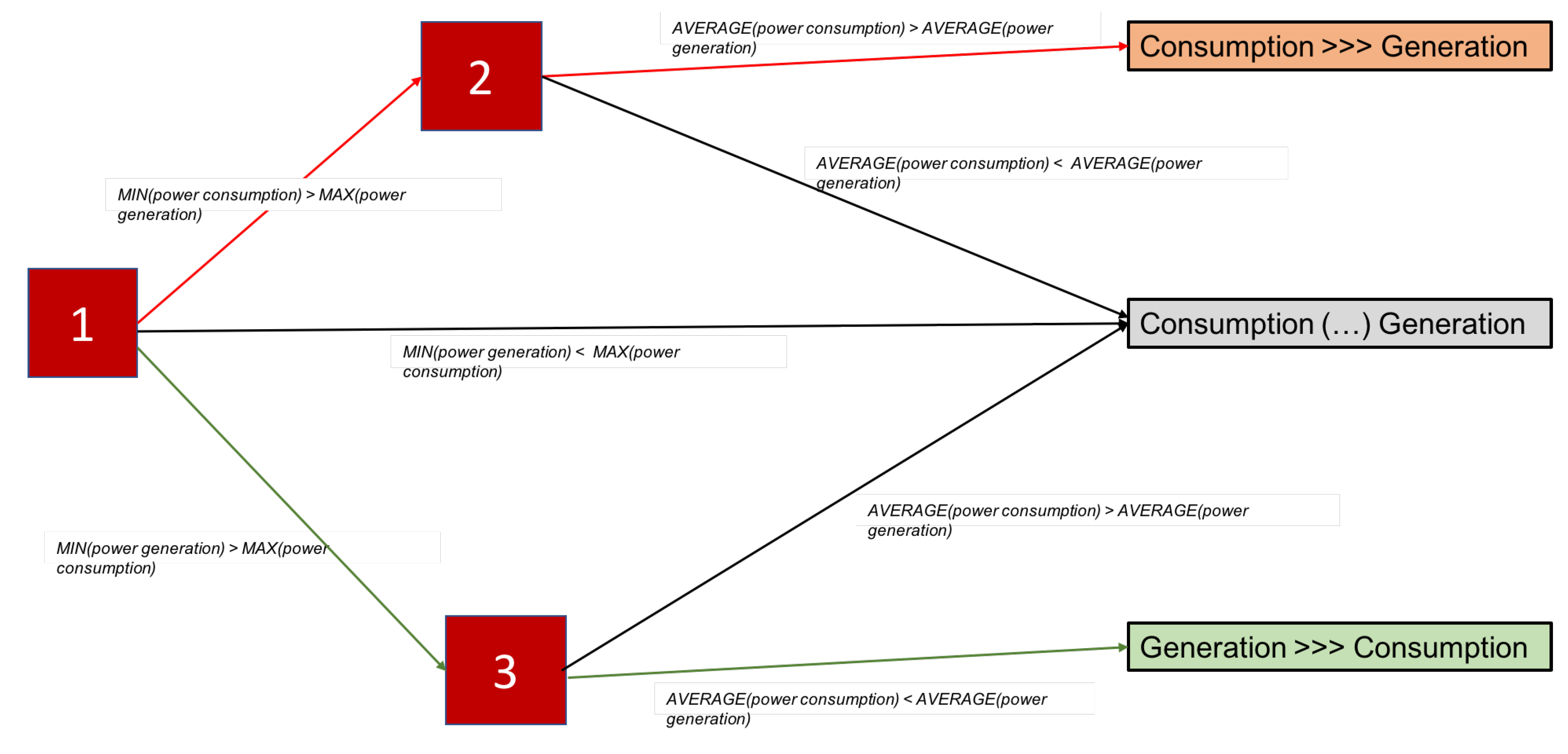
| Operating Mode | Wind Speed (m/s) | |
|---|---|---|
| Cut in | 2 | zone I |
| Rated | 12.5 | zone II |
| Cut out | 26 | zone III |
| Solar Panels | Wind Turbine | Total Production | Consumption | |
|---|---|---|---|---|
| (W) | (W) | (W) | (W) | |
| 00:00 to 1:00 a.m. | - | 100 | 100 | 400 |
| 1:00 to 2:00 a.m. | - | 90 | 100 | 300 |
| 2:00 to 3:00 a.m. | - | 90 | 90 | 300 |
| 3:00 to 4:00 a.m. | - | 80 | 100 | 120.1 |
| 4:00 to 5:00 a.m. | - | 50 | 50 | 120.1 |
| 5:00 to 6:00 a.m. | - | 50 | 50 | 120 |
| 6:00 to 7:00 a.m. | - | 20 | 20 | 120 |
| 7:00 to 8:00 a.m. | - | 20 | 20 | 120.3 |
| 8:00 to 9:00 a.m. | 240.2 | - | 240.2 | 220 |
| 9:00 to 10:00 a.m. | 360.1 | - | 360.1 | 320.5 |
| 10:00 to 11:00 a.m. | 442.9 | 11 | 453.9 | 120.2 |
| 11:00 a.m. to 12:00 p.m. | 485.0 | 30 | 515.0 | 160 |
| 12:00 p.m. to 13:00 p.m. | 485.0 | 95 | 580.0 | 300 |
| 13:00 to 14:00 p.m. | 442.9 | 400 | 842.9 | 900 |
| 14:00 to 15:00 p.m. | 360.1 | 315 | 675.1 | 1200 |
| 15:00 to 16:00 p.m. | 240.1 | 450 | 690.1 | 600 |
| 16:00 to 17:00 p.m. | 79.6 | 450 | 529.6 | 300 |
| 17:00 to 18:00 p.m. | 16.0 | 210 | 226.0 | 100 |
| 18:00 to 19:00 p.m. | - | 340 | 340 | 300.2 |
| 19:00 to 20:00 p.m. | - | 100 | 160 | 600.3 |
| 20:00 to 21:00 p.m. | - | 55 | 55 | 600.5 |
| 21:00 to 22:00 p.m. | - | 55 | 55 | 700 |
| 22:00 to 23:00 p.m. | - | 35 | 35 | 500 |
| 23:00 to 24:00 p.m. | - | 25 | 25 | 500 |
| Total production | 6312.9 | 9022.2 |
Publisher’s Note: MDPI stays neutral with regard to jurisdictional claims in published maps and institutional affiliations. |
© 2018 by the authors. Licensee MDPI, Basel, Switzerland. This article is an open access article distributed under the terms and conditions of the Creative Commons Attribution (CC BY) license (https://creativecommons.org/licenses/by/4.0/).
Share and Cite
Ferrández-Pastor, F.-J.; Gómez-Trillo, S.; Nieto-Hidalgo, M.; García-Chamizo, J.-M.; Valdivieso-Sarabia, R. Intelligent Power Management System Using Hybrid Renewable Energy Resources and Decision Tree Approach. Proceedings 2018, 2, 1239. https://doi.org/10.3390/proceedings2191239
Ferrández-Pastor F-J, Gómez-Trillo S, Nieto-Hidalgo M, García-Chamizo J-M, Valdivieso-Sarabia R. Intelligent Power Management System Using Hybrid Renewable Energy Resources and Decision Tree Approach. Proceedings. 2018; 2(19):1239. https://doi.org/10.3390/proceedings2191239
Chicago/Turabian StyleFerrández-Pastor, Francisco-Javier, Sergio Gómez-Trillo, Mario Nieto-Hidalgo, Juan-Manuel García-Chamizo, and Rafael Valdivieso-Sarabia. 2018. "Intelligent Power Management System Using Hybrid Renewable Energy Resources and Decision Tree Approach" Proceedings 2, no. 19: 1239. https://doi.org/10.3390/proceedings2191239
APA StyleFerrández-Pastor, F.-J., Gómez-Trillo, S., Nieto-Hidalgo, M., García-Chamizo, J.-M., & Valdivieso-Sarabia, R. (2018). Intelligent Power Management System Using Hybrid Renewable Energy Resources and Decision Tree Approach. Proceedings, 2(19), 1239. https://doi.org/10.3390/proceedings2191239





